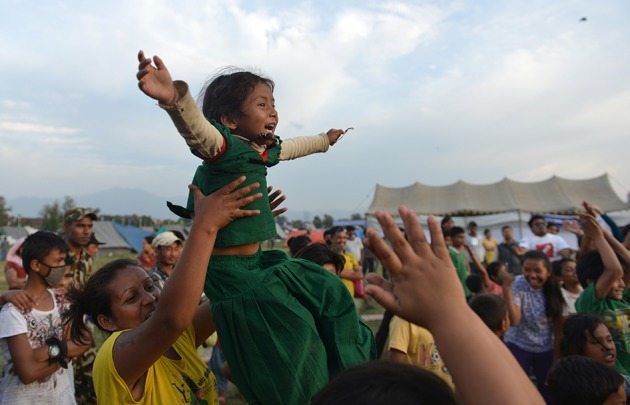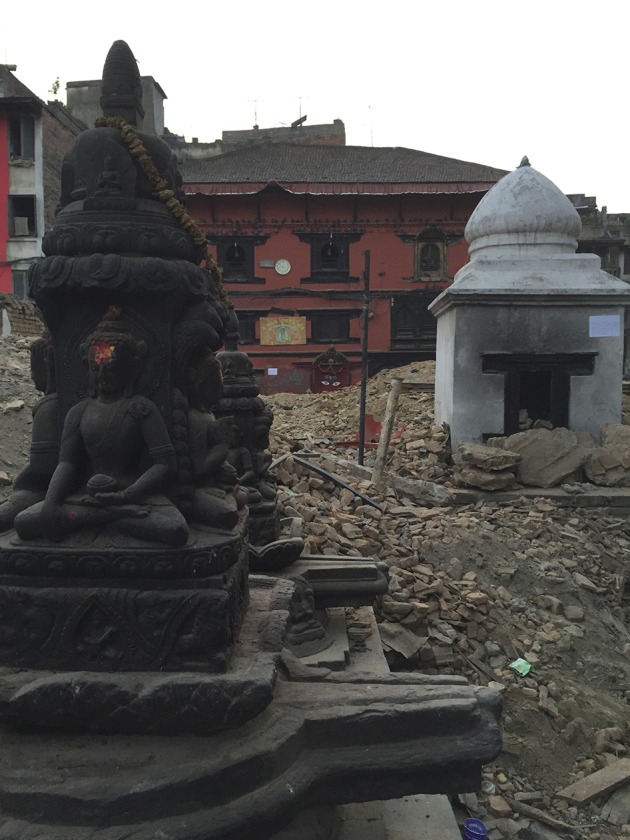Just before noon on April 25, 2015, a massive 7.8 magnitude earthquake occurred about 80 kilometers east of the Nepali capitol of Kathmandu, unleashing considerable destruction in one of the poorest countries in Asia. Then, just 17 days later, a second earthquake with a magnitude of 7.3 struck, this time about 40 kilometers west of Kathmandu. Although predictions of an impending large earthquake in Nepal had motivated the government and local and international nongovernmental organizations to create disaster preparedness plans in recent years,1,2 this disaster affected rural and remote areas where the country’s infrastructure and population were most vulnerable, and where disaster preparedness was weakest.3 The current estimates of casualties and injured are more than 8500 and 15 000 people respectively, and the numbers of internally displaced people are in the hundred of thousands. Most agencies forecast that these numbers will increase over the coming weeks as the strategy shifts to a reconstruction mission.

A Nepalese mother and child participate in a laughter yoga session to help relieve trauma among survivors of two earthquakes, which struck the country in less than three weeks, in Kathmandu on May 15, 2015. Photograph by Prakash Mathema. Printed with permission of AFP/Getty Images.

Kathmandu Durbar Square in the days following the April 25, 2015, earthquake. Photo by Michel D. Landry. Printed with permission.

Collapsed temples in Bhaktapur Durbar Square in Kathmandu, Nepal. Photo by Michel D. Landry. Printed with permission.
THE CHANGING PROFILE OF EARTHQUAKE SURVIVORS
Maya is a seven-year-old Nepali girl who lived with her family in the Lamjung region of Nepal, close to the epicenter of the quake. She was inside her home when the earthquake struck, and the family home crumbled so quickly that no one was able to escape. In that moment her life changed forever. Not only did she lose both of her parents, she also sustained a fractured right humerus, a crush injury of her left leg, and a probable mild traumatic brain injury (although differential diagnoses was difficult because the young girl was in shock and experiencing tremendous acute psychological stress). She was fortunate enough to have been triaged as a high priority and was medically evacuated to a recently opened trauma center in Kathmandu where the medical staff reduced her arm fracture, amputated her leg, and saved her life. However, saving her life was only the beginning. Maya, who remains in hospital as this editorial is written, is now a homeless and parentless child who has a newly acquired lifelong disability. She will require targeted medical, rehabilitative, psychological, social, and financial support to move forward along this new life course. While tragic, Maya’s storyline is now common across the Nepali landscape.
Given technological advances in emergency medicine, it has become fairly routine, and almost expected, to preserve many lives following a natural disaster. However, the effectiveness of acute medical response has resulted in an increase in the number of survivors who have complex medical conditions, such as amputations, spinal cord injuries, and psychosocial trauma, and who now live with significant functional impairments and lifelong disabilities.4 This new group of people in Nepal with postearthquake physical and mental health disabilities, as well as people who had disabilities prior to the earthquake, will now face an unaccommodating landscape, where the lack of basic infrastructure will be layered onto a dearth of vital services for people with disabilities (PWDs).
DISABILITY WITHIN A PUBLIC HEALTH CONTEXT
There are one billion people (15% of the global population) who live with some form of disability.5 The vast majority of PWDs live in low-income settings like Nepal where the presence of disability limits access to primary education, leads to unemployment and underemployment, and creates social isolation and exclusion.6 The United Nations Convention on the Rights of Persons with Disabilities (CRPD), is a human rights treaty that creates policy levers to ensure equal human rights and fundamental freedoms. Nepal became a signatory to CRPD in 2008; however, its ability of ensure adherence to the CRPD is challenged by grinding poverty, high unemployment, and political legislative failures (such as the inability to adopt a permanent constitution a decade after the cessation of civil war), alongside persistent social and political unrest. In times of crises, it can be easy to overlook the importance of how disability can impact the determinants of health, and to underestimate the long-term benefits to individuals and populations of supporting their rights and addressing their needs. Nepal had scarce resources before the earthquake, so we suggest that the process of reconstructing the country’s physical infrastructure be coupled with the health and societal integration of PWDs.
To address earthquake related disability in Nepal and to take advantage of this opportunity build a better disability support system,7 we have five recommendations for humanitarian interventions after disasters.
Support early interventions to minimize long-term disability—Emergency medical procedures that save lives are indispensable. However, those services should not neglect other interventions to prevent long-term disability. For instance, from a physical health perspective, interventions including early physical rehabilitation services can prevent and limit significant impairments after catastrophic injury; from a mental health perspective, intermediate services between emergency psychological first aid and long-term specialized posttraumatic stress disorder services are needed to reduce the duration of posttraumatic psychological disability.
Develop funding mechanisms for long-term financial support for PWDs resulting from the earthquake—As with all emergencies, the largest influx of support is in the emergency period. Proportional funding collected during this period should be set aside for government and nongovernmental programs to provide ongoing financial and logistical support for long-term disability services. The Nepali Prime Minister’s Fund, for instance, which was established to coordinate emergency funding, should also include a long-term component for PWDs.
Provide educational support for PWDs, with a special emphasis on children with disabilities—Education transforms the possibilities for employment for PWDs. Children, such as Maya, will have limited opportunities for physical labor jobs (common for people from rural areas). However, incorporating primary through higher-grade education can enable PWDs to contribute financially, intellectually, and politically to Nepali society. Educational support for children with disabilities is an early intervention that will have lifelong benefit.
Develop integrated disability services—A scattered support system for PWDs is a barrier to holistic and connected care that enables persons to achieve their full personal, professional, and societal potential. A system should be developed to integrate and coordinate disabilities services. For example, case managers could help persons with physical and psychological injuries from the earthquake navigate medical care, mental health care, educational supports, livelihood training, other economic programs, and social inclusion initiatives.
Streamline processes for applying for postearthquake disability support—After the decade-long civil war in Nepal, the government provided financial support for medical care for persons with physical and psychological sequelae for a limited set of acts of government brutality. However, victims often spent years applying for this support during which they went without care. In the process of addressing the previous four recommendations, the government should also ensure a streamlined process by which people can enroll in these services rather than wait years for help.
The two earthquakes and the weeks of powerful aftershocks are a national tragedy for the thousands of persons who will now live with disabilities. However, Nepal and the international community have an opportunity to minimize the burden of disability and enhance quality of life for disabled earthquake survivors. Addressing this major public health need has the potential to transform the lives of all people living with disability in postearthquake Nepal. The dignity, and human rights, for survivors of the earthquake cannot wait for better times.
References
- 1.Pradhan RL. Earthquake preparedness plans—building up capacity and readiness. JNMA J Nepal Med Assoc. 2012;52(185):I–II. [PubMed] [Google Scholar]
- 2.Filmer LB, Ranse J. Who is my Leader? A case study from a hospital disaster scenario in a less developed country. Australas Emerg Nurs J. 2013;16(4):170–174. doi: 10.1016/j.aenj.2013.08.004. [DOI] [PubMed] [Google Scholar]
- 3.Neupane SP. Immediate lessons from the Nepal earthquake. Lancet. 2015;385:2041–2042. doi: 10.1016/S0140-6736(15)60655-9. [DOI] [PubMed] [Google Scholar]
- 4.Zhang L, Zhao M, Fu W et al. Epidemiological analysis of trauma patients following the Lushun earthquake. PLoS ONE. 2014;9(5):e97416. doi: 10.1371/journal.pone.0097416. [DOI] [PMC free article] [PubMed] [Google Scholar]
- 5.World Health Organization. World Report on Disability, 2011. Available at: http://www.who.int/disabilities/world_report/2011/en. Accessed May 20, 2015. [PubMed]
- 6.Parnes P, Cameron D, Christie N, Cockburn L, Hasemi G, Yoshida K. Disability in low-income countries: issues and implications. Disabil Rehabil. 2009;31(14):1170–1180. doi: 10.1080/09638280902773778. [DOI] [PubMed] [Google Scholar]
- 7.World Health Organization. Building Back Better: Sustainable Mental Health Care After Emergencies. Available at: http://www.who.int/mental_health/emergencies/building_back_better/en. Accessed May 26, 2015.


